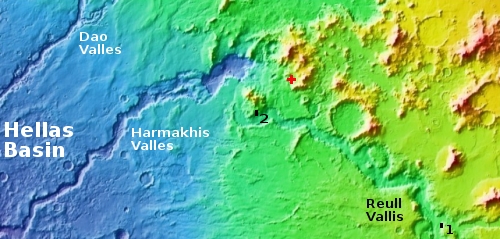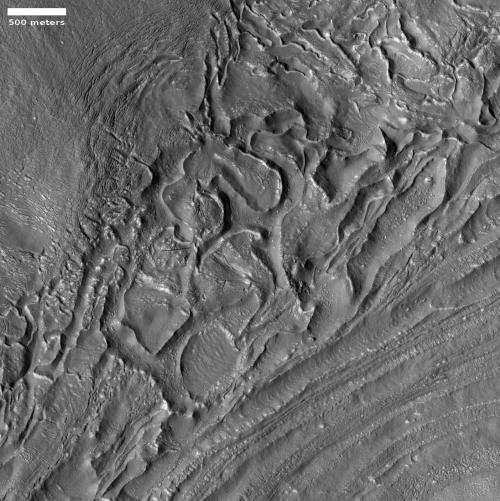Glacial eddies on Mars?
Cool image time! The photo to the right, cropped and reduced to post here, was taken on August 15, 2020 by the high resolution camera on Mars Reconnaissance Orbiter (MRO). It shows a truly strange bunch of blocks beside a clean flow neatly organized in almost straight parallel lines.
What is going on? This location is at 38 degrees south latitude, a latitude where scientists have found a lot of features that resemble water ice glaciers, generally protected from sublimating away by a thin layer of dust and debris.
A first guess is that the smooth glacial flow at the lower right is disturbing the glacial material next to it, causing it to rip apart and break up. At the same time, the hollowed look of these glacial blocks suggests that the ice below that protective debris layer is also slowly sublimating away, causing the surface to sink.
The wider shot below helps confirm this impression.

The white box indicates the area covered in the close-up above. I have added arrows to indicate the flow direction. From this image it appears that the flow that so much resembles many glaciers we see on Earth is disturbing the material on its northern edge, breaking it up into blocks almost like the whirling eddies you see along the shorelines of rivers and streams, generally caused by underwater rocks, boulders, logs, and other impediments to the stream’s smooth flow.
This image is located between two major meandering canyons draining into Hellas Basin — Harmakhis Valles and Reull Valles — as indicated by the red cross in the overview map to the right. I have posted a number of other images from this area, all of which suggest extensive glaciers flowing into these two valleys. The black boxes indicate two, as follows:
- 1. A massive Martian glacier that looks just like a glacier on Earth
- 2. Strange glacial flow features on Mars?
Today’s image only reinforces the impression given by the earlier photos. There is a lot of buried ice in the mountains and valleys to the east of Hellas Basin, and that ice over eons has flowed into the basin, carving out the meandering canyons we see today.
On Christmas Eve 1968 three Americans became the first humans to visit another world. What they did to celebrate was unexpected and profound, and will be remembered throughout all human history. Genesis: the Story of Apollo 8, Robert Zimmerman's classic history of humanity's first journey to another world, tells that story, and it is now available as both an ebook and an audiobook, both with a foreword by Valerie Anders and a new introduction by Robert Zimmerman.
The print edition can be purchased at Amazon or from any other book seller. If you want an autographed copy the price is $60 for the hardback and $45 for the paperback, plus $8 shipping for each. Go here for purchasing details. The ebook is available everywhere for $5.99 (before discount) at amazon, or direct from my ebook publisher, ebookit. If you buy it from ebookit you don't support the big tech companies and the author gets a bigger cut much sooner.
The audiobook is also available at all these vendors, and is also free with a 30-day trial membership to Audible.
"Not simply about one mission, [Genesis] is also the history of America's quest for the moon... Zimmerman has done a masterful job of tying disparate events together into a solid account of one of America's greatest human triumphs."--San Antonio Express-News
Cool image time! The photo to the right, cropped and reduced to post here, was taken on August 15, 2020 by the high resolution camera on Mars Reconnaissance Orbiter (MRO). It shows a truly strange bunch of blocks beside a clean flow neatly organized in almost straight parallel lines.
What is going on? This location is at 38 degrees south latitude, a latitude where scientists have found a lot of features that resemble water ice glaciers, generally protected from sublimating away by a thin layer of dust and debris.
A first guess is that the smooth glacial flow at the lower right is disturbing the glacial material next to it, causing it to rip apart and break up. At the same time, the hollowed look of these glacial blocks suggests that the ice below that protective debris layer is also slowly sublimating away, causing the surface to sink.
The wider shot below helps confirm this impression.

The white box indicates the area covered in the close-up above. I have added arrows to indicate the flow direction. From this image it appears that the flow that so much resembles many glaciers we see on Earth is disturbing the material on its northern edge, breaking it up into blocks almost like the whirling eddies you see along the shorelines of rivers and streams, generally caused by underwater rocks, boulders, logs, and other impediments to the stream’s smooth flow.
This image is located between two major meandering canyons draining into Hellas Basin — Harmakhis Valles and Reull Valles — as indicated by the red cross in the overview map to the right. I have posted a number of other images from this area, all of which suggest extensive glaciers flowing into these two valleys. The black boxes indicate two, as follows:
- 1. A massive Martian glacier that looks just like a glacier on Earth
- 2. Strange glacial flow features on Mars?
Today’s image only reinforces the impression given by the earlier photos. There is a lot of buried ice in the mountains and valleys to the east of Hellas Basin, and that ice over eons has flowed into the basin, carving out the meandering canyons we see today.
On Christmas Eve 1968 three Americans became the first humans to visit another world. What they did to celebrate was unexpected and profound, and will be remembered throughout all human history. Genesis: the Story of Apollo 8, Robert Zimmerman's classic history of humanity's first journey to another world, tells that story, and it is now available as both an ebook and an audiobook, both with a foreword by Valerie Anders and a new introduction by Robert Zimmerman.
The print edition can be purchased at Amazon or from any other book seller. If you want an autographed copy the price is $60 for the hardback and $45 for the paperback, plus $8 shipping for each. Go here for purchasing details. The ebook is available everywhere for $5.99 (before discount) at amazon, or direct from my ebook publisher, ebookit. If you buy it from ebookit you don't support the big tech companies and the author gets a bigger cut much sooner.
The audiobook is also available at all these vendors, and is also free with a 30-day trial membership to Audible.
"Not simply about one mission, [Genesis] is also the history of America's quest for the moon... Zimmerman has done a masterful job of tying disparate events together into a solid account of one of America's greatest human triumphs."--San Antonio Express-News



